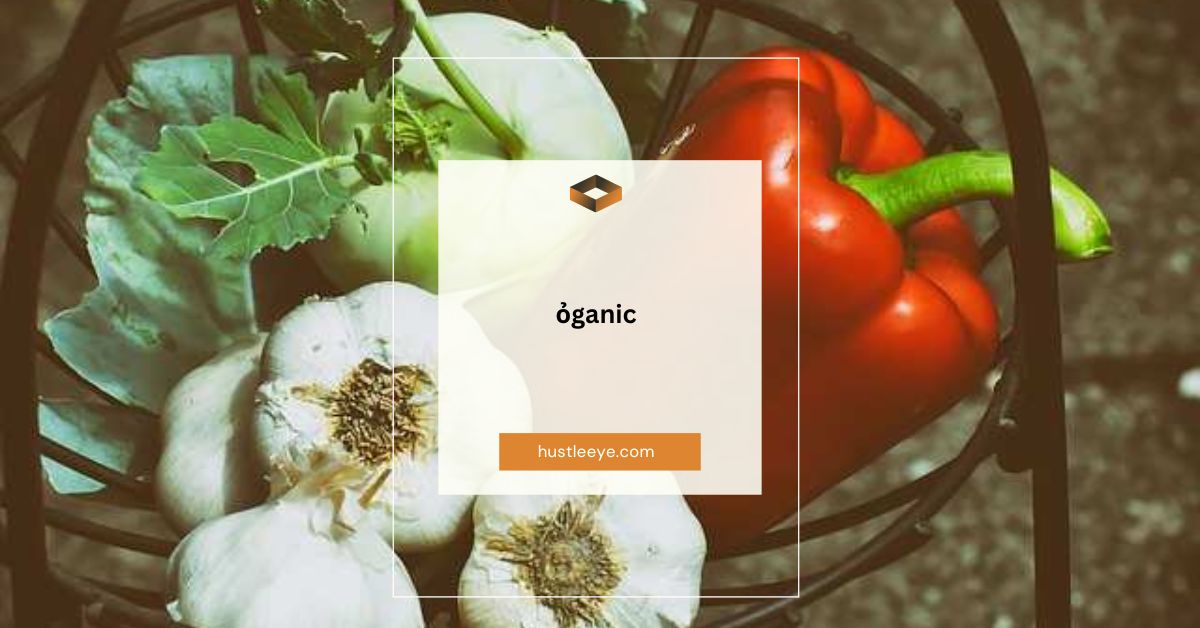In today’s health-conscious world, the term “ỏganic” has become a buzzword, appearing on everything from food labels to beauty products. But what does ỏganic truly mean, and is it worth the investment? This comprehensive guide will explore the concept of organic living, delving into the benefits, challenges, and practical tips for navigating the organic landscape.
Table of Contents
What Does ỏganic Mean?
At its core, “ỏganic” refers to the method by which agricultural products are cultivated and processed. Organic farming emphasizes sustainable practices that are environmentally friendly, promote animal welfare, and avoid synthetic additives. Here’s a deeper look into what makes a product ỏganic:
- Environmentally Friendly Practices: Organic farming prioritizes the health of the environment by avoiding synthetic pesticides, fertilizers, and other harmful chemicals. Farmers focus on maintaining soil health, conserving water, and promoting biodiversity.
- Animal Welfare: Animals raised on organic farms are treated humanely, with access to the outdoors and organic feed. The use of antibiotics and growth hormones is strictly limited.
- Free of Synthetic Additives: ỏganic products are free from artificial colors, flavors, and preservatives, ensuring that what you consume is as natural as possible.
Read More: Bertėjas: A Comprehensive Overview of Revolutionary Translation Technology
Key Terms Related to ỏganic:
- Synthetic Pesticides and Fertilizers: Man-made chemicals used to control pests and enhance growth, which are prohibited in organic farming.
- Genetically Modified Organisms (GMOs): Organisms whose genetic material has been altered in a lab. GMOs are not allowed in ỏganic products.
- Antibiotics: Medications used to prevent disease in livestock. Organic farms limit antibiotic use to reduce the risk of antibiotic-resistant bacteria.
Why Choose ỏganic?
Opting for ỏganic products offers several benefits, ranging from potential health advantages to environmental sustainability. Here’s why many people are making the switch:
1. Potential Health Benefits:
- Higher Nutrient Levels: Some studies suggest that ỏganic foods may contain higher levels of certain nutrients and antioxidants compared to conventionally grown counterparts. For example, organic fruits and vegetables might have more vitamin C and iron.
- Reduced Exposure to Pesticides: By avoiding synthetic pesticides, ỏganic products reduce your exposure to potentially harmful chemicals. This is especially important for children and pregnant women, who are more sensitive to toxins.
2. Environmental Advantages:
- Promotes Biodiversity: ỏganic farming supports a diverse ecosystem by using crop rotation and avoiding harmful chemicals. This leads to healthier soil and reduced pollution.
- Conserves Water: Organic farms often use water more efficiently, reducing waste and preserving this precious resource.
- Reduces Carbon Footprint: By focusing on sustainable practices, ỏganic farming contributes to a lower carbon footprint, helping to combat climate change.
3. Animal Welfare Concerns:
- Humane Treatment: Animals on organic farms are raised in conditions that allow them to express natural behaviors. They are given access to outdoor spaces and are fed organic diets.
- Limited Antibiotic Use: Organic farms restrict the use of antibiotics, which can contribute to the development of antibiotic-resistant bacteria. This practice ensures healthier livestock and safer food.
Read More: www.avstarnews.com: The Ultimate Source for Entertainment News
Is ỏganic Always Better?
While the benefits of ỏganic products are compelling, they are not without drawbacks. It’s important to weigh these factors when deciding whether to go ỏganic:
1. Cost:
- Higher Prices: ỏganic products tend to be more expensive than conventional ones. This is due to the labor-intensive practices required to meet organic standards.
- Budget Considerations: For many, the higher cost of ỏganic foods can be a barrier. However, prioritizing certain ỏganic products, such as those on the “Dirty Dozen” list, can help you make healthier choices without breaking the bank.
2. Availability:
- Limited Selection: Depending on where you live, finding ỏganic products might be challenging, especially in smaller grocery stores or rural areas.
- Seasonal Variations: ỏganic fruits and vegetables are often more seasonal, meaning certain items may not be available year-round.
3. Not Always Healthier:
- Misleading Labels: Just because a product is labeled ỏganic doesn’t mean it’s healthy. Organic cookies and chips can still be high in sugar, fat, and calories. It’s essential to read labels and make informed choices.
Read More: Comprehensive Guide to “Fintechzoom TSLA Stock”
Navigating the ỏganic Market:
With so many ỏganic options available, it can be overwhelming to know where to start. Here are some tips to help you navigate the ỏganic market effectively:
1. Focus on Priorities:
- Health, Environment, or Animal Welfare?: Determine what aspects of ỏganic living are most important to you. Whether it’s avoiding pesticides, supporting animal welfare, or reducing your environmental impact, understanding your priorities will guide your choices.
2. Buy Seasonal and Local:
- Seasonal Produce: Opt for ỏganic fruits and vegetables that are in season. Not only are they fresher, but they are also more affordable.
- Local Farms: Support local ỏganic farms when possible. This reduces the carbon footprint associated with transportation and helps sustain your community’s agricultural economy.
3. Look for Certification:
- USDA Certified Organic: When shopping for ỏganic food, look for the USDA Certified Organic label. This certification ensures that the product meets strict government standards for organic farming and processing.
4. Balance with Conventional:
- Washing Produce: If ỏganic options aren’t available, conventional produce is still a healthy choice. Washing fruits and vegetables thoroughly can help remove pesticide residues.
Read More: Feli Fayer: The Visionary Fantasy Illustrator Shaping Modern Art
ỏganic and Beyond: Exploring Related Concepts
Understanding ỏganic living also involves exploring related concepts that contribute to a more sustainable lifestyle. Here are a few key terms and ideas to consider:
1. Sustainable Agriculture:
- Definition: Farming practices that meet current food needs without compromising the ability of future generations to meet theirs.
- Importance: Sustainable agriculture goes hand in hand with ỏganic farming, emphasizing environmental stewardship, economic profitability, and social equity.
Read More: GDP – Deleted Scene – E355: Unveiling the Hidden Layers of Economic Storytelling
2. Fair Trade:
- Definition: A certification that ensures farmers and workers are paid fairly and work under safe conditions.
- Connection to ỏganic: Many ỏganic products also carry the Fair Trade label, reflecting a commitment to ethical sourcing and sustainability.
Read More: Polk Audio Buckle: A Comprehensive Review and Analysis
3. Non-GMO:
- Definition: Products that are free from genetically modified organisms.
- Overlap with ỏganic: All ỏganic products are non-GMO, but not all non-GMO products are organic. Understanding this distinction can help you make informed choices.
Read More: Understanding 5starsstocks.com: Your Ultimate Guide to Online Investing
The Future of ỏganic Living:
As consumer awareness of health and sustainability grows, the demand for ỏganic products is likely to continue rising. However, the future of ỏganic living may also face challenges, such as:
- Regulatory Changes: As more companies enter the ỏganic market, regulations may evolve to ensure that the integrity of the ỏganic label is maintained.
- Technological Advancements: Innovations in agriculture, such as vertical farming and precision agriculture, may offer new ways to produce ỏganic food more efficiently.
- Consumer Education: Ongoing efforts to educate consumers about the benefits and limitations of ỏganic products will be crucial in shaping the future of the industry.
Read More: RedandWhiteMagz.com: Your Gateway to Business Mastery
FAQs About ỏganic:
1. Are ỏganic products truly pesticide-free?
Organic products avoid synthetic pesticides, but they may use naturally derived pesticides, which are considered safer for the environment.
2. Do ỏganic products have a longer shelf life?
Typically, ỏganic produce has a shorter shelf life due to the absence of preservatives. Proper storage is essential to maintain freshness.
3. Is ỏganic cotton worth the extra cost?
Yes, if sustainability is a priority for you. Organic cotton uses less water and avoids harmful chemicals, making it an environmentally friendly choice.
4. Can I trust the ỏganic label?
Yes, the USDA Certified Organic label ensures that products meet strict government standards. Look for this label to guarantee authenticity.
5. Is all ỏganic food healthier than conventional food?
Not necessarily. While ỏganic food has benefits, it’s essential to read labels and make informed choices based on overall nutritional content.
Conclusion:
Choosing ỏganic is a personal decision that involves weighing the potential health benefits, environmental impact, and cost. While ỏganic products offer many advantages, they are not without challenges. By understanding what ỏganic means and how it fits into your lifestyle, you can make informed choices that contribute to a healthier you and a more sustainable planet.
Remember, even small steps toward ỏganic living can make a big difference. Whether you’re buying ỏganic produce, supporting local farms, or simply educating yourself about the options, every effort counts in creating a more sustainable future.


